-

新人教版高中英语必修2Unit 5 Music-Discovering Useful Structures教案一
Step1:自主探究。1.(教材P52)Born(bear) in the USA on 2 January 1970, Whitacre began studying music at the University of Nevada in 1988.2.(教材P52) Moved(move) by this music, he said, “It was like seeing color for the first time.”3.(教材P56)I was very afraid and I felt so alone and discouraged(discourage).4.(教材P58)Encouraged(encourage) by this first performance and the positive reaction of the audience, I have continued to play the piano and enjoy it more every day.Step2:语法要点精析。用法1:过去分词作表语1).过去分词可放在连系动词be, get, feel, remain, seem, look, become等之后作表语,表示主语所处的状态Tom was astonished to see a snake moving across the floor.汤姆很惊讶地看到一条蛇正爬过地板。Finally the baby felt tired of playing with those toys.终于婴儿厌倦了玩那些玩具。注意:1).过去分词作表语时与被动语态的区别过去分词作表语时,强调主语所处的状态;而动词的被动语态表示主语是动作的承受者,强调动作。The library is now closed.(状态)图书馆现在关闭了。The cup was broken by my little sister yesterday.(动作)昨天我妹妹把杯子打碎了。2)感觉类及物动词的现在分词与过去分词作表语的区别过去分词作表语多表示人自身的感受或事物自身的状态,常译作“感到……的”;现在分词多表示事物具有的特性,常译作“令人……的”。
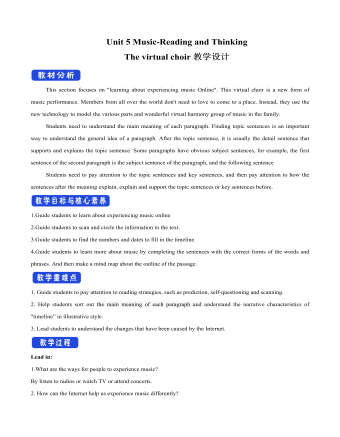
新人教版高中英语必修2Unit 5 Music-Reading and Thinking教案一
This section focuses on "learning about experiencing music Online". This virtual choir is a new form of music performance. Members from all over the world don't need to love to come to a place. Instead, they use the new technology to model the various parts and wonderful virtual harmony group of music in the family. Students need to understand the main meaning of each paragraph. Finding topic sentences is an important way to understand the general idea of a paragraph. After the topic sentence, it is usually the detail sentence that supports and explains the topic sentence. Some paragraphs have obvious subject sentences, for example, the first sentence of the second paragraph is the subject sentence of the paragraph, and the following sentenceStudents need to pay attention to the topic sentences and key sentences, and then pay attention to how the sentences after the meaning explain, explain and support the topic sentences or key sentences before.1.Guide students to learn about experiencing music online2.Guide students to scan and circle the information in the text.3.Guide students to find the numbers and dates to fill in the timeline.4.Guide students to learn more about music by completing the sentences with the correct forms of the words and phrases. And then make a mind map about the outline of the passage.1. Guide students to pay attention to reading strategies, such as prediction, self-questioning and scanning.2. Help students sort out the main meaning of each paragraph and understand the narrative characteristics of "timeline” in illustrative style.3. Lead students to understand the changes that have been caused by the Internet.

新人教版高中英语必修2Unit 5 Music-Reading For Writing教案一
(4)Now we have heard a number of outstanding speeches ... 我们已经聆听了许多精彩的发言……(5)Because we wanted the nations of the world, working together, to deal with ... 因为我们希望全世界各国团结起来去应对……(6)And if we do not act ... 如果我们不采取行动……(7)Now, I share the concerns that have been expressed ... 我也同意对于……表达的担心(8)Let us show the world that by working together we can ... 让我们告诉全世界,通过一起努力我们可以……(9)It is now time for us to ... 是时候我们……(10)And I have always wished that ... 我一直希望……(11)Thank you for letting me share this day with me.感谢你们和我共度这一天。实践演练:假如你是高中生李华,你校将举办一次以“音乐”为主题的演讲比赛,请你按照主题,写下你的演讲稿。注意:词数100左右。First of all, thank you for listening to my speech. My topic is: love music like love yourself.Music is like the air we need to maintain our normal lives around us. You can't imagine how terrible a world without music would be. Movies and TV shows have no music, only dry conversations and scenes; mobile phones only vibrations; streets only noisy crowds; cafes, western restaurants only depressed meals. What a terrible world it is!As a student, I hope we all can enjoy the fun brought by music in our spare time. Instead of just listening to music, we can even make our own music. Let's enjoy the fun of music!Thanks again for your attention!

新人教版高中英语必修3Unit 1 Festivals and Celebrations教学设计一
本板块的活动主题是“谈论节日活动”(Talk about festival activities),主要是从贴近学生日常生活的角度来切入“节日”主题。学生会听到发生在三个国家不同节日场景下的简短对话,对话中的人们正在参与或将要亲历不同的庆祝活动。随着全球化的进程加速,国际交流日益频繁,无论是国人走出国门还是外国友人访问中国,都已成为司空见惯的事情。因此,该板块所选取的三个典型节日场景都是属于跨文化交际语境,不仅每组对话中的人物来自不同的文化背景,对话者的身份和关系也不尽相同。1. Master the new words related to holiday: the lantern, Carnival, costume, dress(sb)up, march, congratulation, congratulate, riddle, ceremony, samba, make - up, after all. 2. To understand the origin of major world festivals and the activities held to celebrate them and the significance of these activities;3. Improve listening comprehension and oral expression of the topic by listening and talking about traditional festivals around the world;4. Improve my understanding of the topic by watching pictures and videos about different traditional festivals around the world;5. Review the common assimilation phenomenon in English phonetics, can distinguish the assimilated phonemes in the natural language flow, and consciously use the assimilation skill in oral expression. Importance:1. Guide students to pay attention to the attitude of the speaker in the process of listening, and identify the relationship between the characters;2. Inspire students to use topic words to describe the festival activities based on their background knowledge. Difficulties:In the process of listening to the correct understanding of the speaker's attitude, accurately identify the relationship between the characters.

新人教版高中英语必修3Unit 2 Morals and virtues教学设计一
(2) students are divided into groups according to the requirements of activity 3. Each student shares a story of personal experience or hearing-witnessing kindness, and then selects the most touching story in the group and shares it with the whole class. Before the students share the story, the teacher can instruct them to use the words and sentence patterns in the box to express. For example, the words in the box can be classified:Time order: first of all, then, after that, later, finally logical relationship :so, however, although, butTeachers can also appropriately add some transitional language to enrich students' expression:Afterwards, afterwards, at last, in the end, eventuallySpatial order: next to, far from, on the left, in front ofOtherwise, nevertheless, as a result, therefore, furthermore, in addition, as well asSummary: in a word, in short, on the whole, to sum up, in briefStep 8 Homework1. Understand the definition of "moral dilemma" and establish a correct moral view;2. Accumulate vocabulary about attitudes and emotions in listening texts and use them to express your own views;3. Complete relevant exercises in the guide plan.1、通过本节内容学习,学生能否理解理解“道德困境”的定义;2、通过本节内容学习,学生能否通过说话人所表达的内容、说话的语气、语调等来判断其态度和情绪;3、通过本节内容学习,学生能否针对具体的道德困境发表自己的看法和见解,能否掌握听力理训练中的听力策略。

新人教版高中英语必修3Unit 3 Diverse Cultures教学设计一
Activity 81.Grasp the main idea of the listening.Listen to the tape and answer the following questions:Who are the two speakers in the listening? What is their relationship?What is the main idea of the first part of the listening? How about the second part?2.Complete the passage.Ask the students to quickly review the summaries of the two listening materials in activity 2. Then play the recording for the second time.Ask them to complete the passage and fill in the blanks.3.Play the recording again and ask the students to use the structure diagram to comb the information structure in the listening.(While listening, take notes. Capture key information quickly and accurately.)Step 8 Talking Activity 91.Focus on the listening text.Listen to the students and listen to the tape. Let them understand the attitudes of Wu Yue and Justin in the conversation.How does Wu Yue feel about Chinese minority cultures?What does Justin think of the Miao and Dong cultures?How do you know that?2.learn functional items that express concerns.Ask students to focus on the expressions listed in activity. 3.And try to analyze the meaning they convey, including praise (Super!).Agree (Exactly!)"(You're kidding.!)Tell me more about it. Tell me more about it.For example, "Yeah Sure." "Definitely!" "Certainly!" "No kidding!" "No wonder!" and so on.4.Ask the students to have conversations in small groups, acting as Jsim and his friends.Justin shares his travels in Guizhou with friends and his thoughts;Justin's friends should give appropriate feedback, express their interest in relevant information, and ask for information when necessary.In order to enrich the dialogue, teachers can expand and supplement the introduction of Miao, dong, Lusheng and Dong Dage.After the group practice, the teacher can choose several groups of students to show, and let the rest of the students listen carefully, after listening to the best performance of the group, and give at least two reasons.
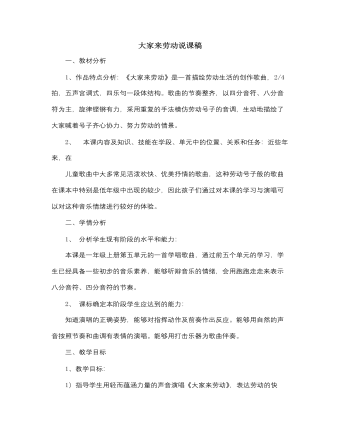
人音版小学音乐一年级上大家来劳动说课稿
2、师:"今天的音乐课上老师要带大家一起来劳动(出示课题),同学们有修桌子的叮当叮当、有擦桌子的擦擦,还有扫地的刷刷(按顺序出示节奏),让我们大家一起行动起来,加入劳动的行列。用劳动的声音来读一读,看看谁读的最准确。"(学生用劳动的声音来读的节奏实际就是歌曲的节奏,用这种方式可以让学生在潜移默化中学会歌曲中的重点节奏)[课件节奏谱]1)学生分三组按顺序读,一组读修桌子节奏,一组读擦桌子节奏,一组读扫地节奏。(这样做是为了培养学生相互配合、协作的能力)2)集体连读三、歌曲学习1、感受歌曲情绪1)师:"同学们读的很准确,反应很灵敏。看得出你们在劳动时也是非常卖力的,现在老师也想为你们这些劳动的小能手鼓劲,请你们听听老师是怎样表示的?"[课件出示前两句歌词](难点)师拿响板边拍边读:嗨哟加把劲呦,嗨哟里格嗨哟呵呵师:"刚才老师怎样为小能手加油的?"学生:嗨哟······师:你们能不能
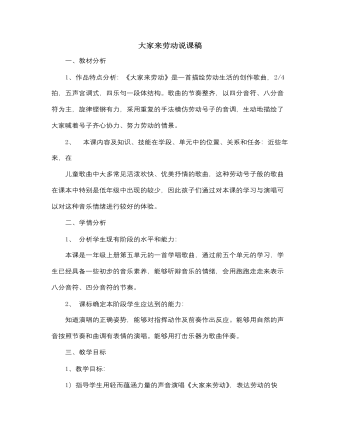
人音版小学音乐一年级上袋鼠说课稿
设计意图:幼儿听着音乐磁带边表演边唱,把自己想象是一只小袋鼠,能用自己的动作非常投入地表演起来,这种耳闻目染的熏陶,一下子就将幼儿身心带进音乐的殿堂,群情激动,气氛达到高潮。4、感受猎人打枪及狼中枪后的游戏规则:(1)音乐结束,猎人打枪,狼倒下。(2)猎人检查狼是否死了。假如有袋鼠动了,狼就立即爬起抓住袋鼠,老师问:这只袋鼠为什么被狼抓住?(猎人开枪后,还没有检查狼是不是死了,袋鼠就动了。而这只狼很狡猾,它装死,实际上它还没有死,它看见袋鼠动了,就扑过去把它捉住了)猎人随机又开枪,将大灰狼打死。老师旁白:“狼死了没有,还不知道呢?小袋鼠可千万不能动。”猎人检查完后,说“大灰狼被打死了!”老师带领小袋鼠欢呼:“大灰狼被打死了!”,听歌曲《袋鼠》高高兴兴回家。5、幼儿完整玩游戏。进一步强调游戏规则。6、结束部分:“大灰狼被打死了!” “大灰狼被打死了!”,听歌曲《袋鼠》小袋鼠跟着妈妈高高兴兴回家。
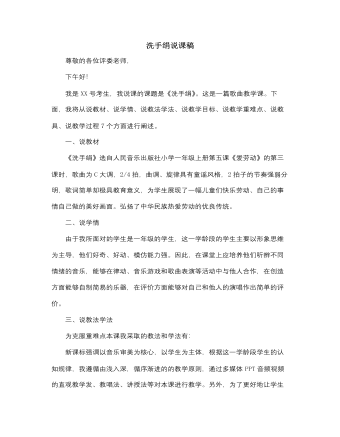
人音版小学音乐一年级上洗手绢说课稿
理论离不开实践,这个环节,为了让学生更好地体验歌曲的民谣风格,并且亲身践行自己的事情自己做和感受劳动的快乐,我将学生分成4个小组,随意解下自己的红领巾,放在讲台上事先准备的洗衣盆里清洗,并对歌词进行改编套入本曲中,边唱边洗,当唱到休止符时,要求他们做一个拧干水的动作,如:2/4 1 1 2 1 1 2 3 2 3 0: 哎 啰 哎 啰 哎 啰 哎 拧水让学生感受本曲中歌词及休止符带来的劳动感。接着,让学生对自己及他人的表现进行自评与他评,最后我来评价哪组洗的最好。让学生在做中学。最后,是我本课的教学总结本课教学,我运用了柯达伊体态律动教学法、示范法、讲授法、多媒体展示法和活动创编等方法,引导学生从多角度、多方面、多层次去体验音乐情感,通过柯达伊的律动教学,触动学生的音乐连觉反应,使其有本能的音乐反应,对学生以后形成正确的音乐学习观有着积极影响。
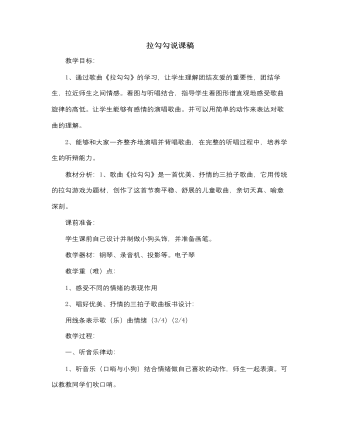
人音版小学音乐一年级上拉勾勾说课稿
三、创造表现:1、边唱边表演(自由结合小组),分组站成圆圈并拍手做动作演唱歌曲《拉勾勾》。2、组织游戏,不要求动作统一,提倡学生自编自演,总结哪一组表演好哪一组演唱好并评奖。四、完美结课:教师发奖总结同学们应团结友爱和每个人都应成为好朋友教学点评:在本课教学中我设计了游戏《拉勾勾、找朋友》紧密结合了本课教学内容,将音乐教学巧妙地溶合进游戏中,让学生在游戏中学习感觉理解音乐,激发学生团结友爱的情感,调动了学生学习的积极、主动性,课堂效果很好!通过创设情境和让学生画头饰等教学手段将学生融入音乐内容之中,从而更好地理解感受乐曲所表现的内容,通过本课教学,今后更应重视对学生能力的培养,如表现音乐、即兴创造等能力。让学生在理解音乐的基础上对音乐有自己的感受和评判,不限制学生对音乐的想象,充分保护学生的想象空间,使学生充分发挥想象力提高理解、感受音乐能力。
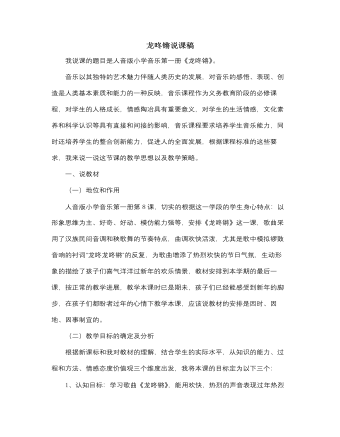
人音版小学音乐一年级上龙咚锵说课稿
五、教学特色(总结以上过程和策略,我认为我的教学特色是)1、面向全体学生,突出学科特点。2、创造合作互动,尊重独特体验。3、运用现代手段,实现学科整合。六、板书设计我采用了图文式板书——清晰明了,具有艺术性、启发性,将难点进行突破,形象生动,让学生一目了然。七、教学启示总之,本方案设计,力求体现以人为本的思想,着眼于学生的主动发展,致力于运用现代信息技术优化课堂教学,通过充分的音乐实践培养学生的能力,提高音乐素养,依托音乐本身的魅力,影响学生人生观、审美观、价值观的形成,培养学生主动学习、合作意识,探究精神,从目标的提出到过程的安排,学习方法的确定,乃至学习成果的呈现都让学生有更大的自主性,更多的实践性,更浓的创造性,当然,措施付诸实施,还需要老师的爱心和慧心,教学研究永无止境,我相信,没有最好,只有更好,在此,还请各位老师和同行们提出宝贵意见,谢谢!
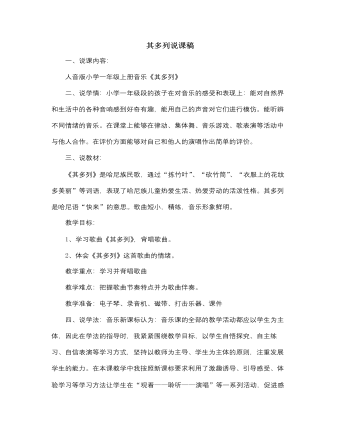
人音版小学音乐一年级上其多列说课稿
1、一堂课必须有一个好的导入做为前奏,来调动学习兴趣,在这一课的教学过程中导入部分我利用了北京奥运会升旗仪式的一个片段让学生感受56个民族团结在一起的美好场面。接着我用多媒体课件让学生认识了几个比较有特点的少数民族来导入本课的主课题《其多列》。2、音乐是听觉的艺术,音乐教育首先要解决的问题是要学生学会聆听,使学生养成聆听的习惯逐步拥有音乐的耳朵,是我们音乐教师不可推卸的责任,因此在学唱歌曲时我设计了以下几个环节:(1)、初听全曲。让学生在歌词和音调中感受歌曲的风格特点。(2)、再次听全曲。让学生在模仿劳动时的动作来感受歌曲的节奏特点。(3)、看课件欣赏全曲。通过对歌曲动画的欣赏,加深学生对歌曲的整体感,对学习歌词奠定基础。(4)、在学习歌词过程中,我以一个提问者的身份,并利用键盘让学生边听琴声边轻声逐步掌握歌词,

人音版小学音乐一年级上玩具兵进行曲说课稿
这就充分说明了别看低年级孩子年龄小,但相信只要通过仔细聆听,认真思考,低年级学生在他们的层面上也完全有能力感悟音乐的内涵所在。最后在孩子们充分发挥想象力后,教师再简单地揭示本课的主题以及作者和创作背景,尽可能地为每一位学生搭建一个展现自我风采的舞台。在感知《玩具兵进行曲》的基础上,再以 " 优化学习的方式,进行教学反馈。 " 让学生亲自体验创作运用多种不同的形式(如:合唱分组、舞蹈表演、乐器演奏等形式)对歌曲《玩具进行曲》进行分组表演的乐趣。在表现 " 玩具木偶 " 愉悦心情的同时,通过生生互动、师生互动、略带游玩式的教学形式,以次来培养学生对音乐的兴趣,把课堂又推向一个新的高潮。本课的设计力求能引起学生学习音乐的愿望,强化审美体验,给学生带来愉悦的教学方法。当然课的设计还存在着许多的不足,设计者渴望得到各位专家和老师的指点与帮助。同时希望引起对此问题的共同探究和研究,摸索出一套行之有效的教学方法。
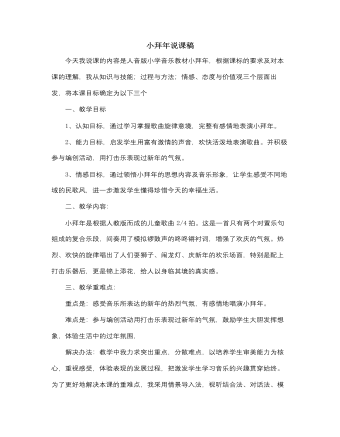
人音版小学音乐一年级上小拜年说课稿
1、为音乐配打击乐打击乐器是小学生喜欢的乐器。让学生在音乐课上演奏打击乐器,不但可以提高学生的学习兴趣,同时也能培养对音乐的感知力。让学生为乐曲加上打击乐器伴奏。在鼓、钹声中,学生的参与意识被激发。加强了学生对音乐的理解,增强了音乐的表现力。(五)拓展延伸 。 1、让音乐与生活沟通起来音乐本来就是从生活中创造出来的。我们在音乐教学过程中根据教学需要,实现教师、学生、教材、教具、教学环境与生活的多方面横向联系,及他们之间的相互作用和影响。 (六)、课堂小结。课堂小结:是在完成某项教学任务的终了阶段,教师富有艺术性的对所学知识和技能进行归纳、总结和升华的行为方式,它常用于课堂的结尾,所以形象地被称作"豹尾"。完善、精要的"小结",可以使课堂教学锦上添花,余味无穷,让学生达到前后浑然一体的美妙境界,以激发学生学习音乐课的热情,同时性情也受到熏陶。
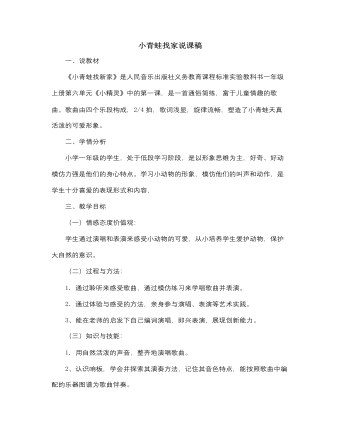
人音版小学音乐一年级上小青蛙找家说课稿
(三)、学唱歌曲本环节通过学生聆听录音范唱让学生初步接触歌曲,感受音乐形象。通过学生熟悉歌曲,模仿小青蛙的叫声,用听唱法学习歌曲,教师用电子琴纠正唱不准的地方,慢慢学会演唱歌曲,通过启发,用声音和动作处理歌曲并能声情并茂的唱歌。(四)、为歌曲加入伴奏让学生自己观察响板,探索其演奏方法,再根据图片上的图谱用打击乐器为歌曲加入伴奏。(五)、创编歌词这个环节体现本课的另外一个难点,教师用生动的语言将孩子的思维再次打开,请他们通过模仿其他小动物的声音填词歌唱,培养了学生的想象力和创造力,使课堂气氛更加的生动活泼。七、本课小结先让学生说说本节课的收获,教师再做最后的总结,教育学生要爱护动物保护动物,做动物的好朋友,渗透德育教育。最后在歌声中结束本课。
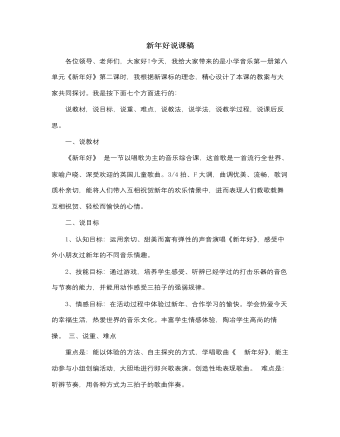
人音版小学音乐一年级上新年好说课稿
一、说教材《新年好》 是一节以唱歌为主的音乐综合课,这首歌是一首流行全世界、家喻户晓、深受欢迎的英国儿童歌曲。3/4拍、F大调,曲调优美、流畅,歌词质朴亲切,能将人们带入互相祝贺新年的欢乐情景中,进而表现人们载歌载舞互相祝贺、轻松而愉快的心情。二、说目标1、认知目标:运用亲切、甜美而富有弹性的声音演唱《新年好》,感受中外小朋友过新年的不同音乐情趣。2、技能目标:通过游戏,培养学生感受、听辨已经学过的打击乐器的音色与节奏的能力,并能用动作感受三拍子的强弱规律。3、情感目标:在活动过程中体验过新年、合作学习的愉快。学会热爱今天的幸福生活,热爱世界的音乐文化。丰富学生情感体验,陶冶学生高尚的情操。 三、说重、难点重点是:能以体验的方法、自主探究的方式,学唱歌曲《 新年好》,能主动参与小组创编活动,大胆地进行即兴歌表演。创造性地表现歌曲。 难点是:听辨节奏,用各种方式为三拍子的歌曲伴奏。
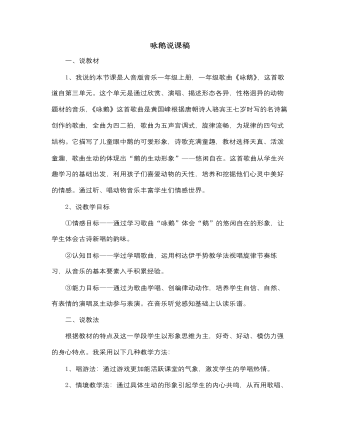
人音版小学音乐一年级上咏鹅说课稿
④生分为两组,一组用手模仿鹅嘴巴上下合闭的动作。边念嘎嘎……另一组用响板在同样的地方X X X | X O |配合。一起合作创造丰富歌曲的音响效果,培养了学生间的协作能力。(这一环节师弹琴,生边唱边合作,完整的一首歌曲)。4、律动创编教学。①让学生模仿一下,自己观察过鹅的各种各样的动作神态,用肢体初步体验。②模仿得太好了。我们一起来欣赏一下,舞蹈演员们是如何通过舞蹈动作模仿美丽的天鹅。出示多媒体课件——播放相关的视频,如芭蕾舞“四小天鹅”或“天鹅湖的片段”等。3、师:他们的舞姿太美了,我们也为我们这首歌曲创编上好看的动作吧。①根据歌词内容引导学生一段段创编动作。②教师可以指导完成律动创编,并且师表演一遍自己创编的律动。③师生随着音乐,进行律动,学生可以模仿老师的动作,也可以加上自己创编的动作。完整的演艺律动,从听觉、视觉和肢体知觉感受这首歌曲。(师示范一遍律动)
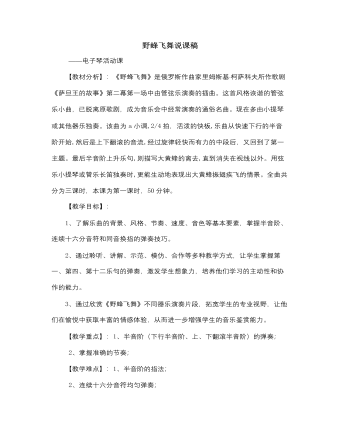
人音版小学音乐一年级上野蜂飞舞说课稿
1、振翅疾飞,“下行式”半音阶。a)掌握连续十六分音符节奏;b)学习“下行式”半音阶;c)分析指法,模仿练习; d)学生练习,教师辅导;2、野蜂飞舞,“上、下翻滚式”半音阶。a)视唱,划拍,熟悉第四乐句;b)分析、讨论指法,练习弹奏;3、“嗡嗡”作响,同音换指。a)聆听第十二乐句旋律;b)教师示范,学生观摩;c)学生练习弹奏;四、拓展巩固1、选音色;a)讨论音色:长笛、双簧管、弦乐、钢琴、圆号等多种音色;b)自主选择音色,自由练习;c)展示不同音色的不同听觉效果,互相观摩;2、加节奏;a)教师加节奏示范,讲解弹奏要领;b)学生尝试练习,教师指导;c)跟节奏慢速齐奏;3、加速度;a)赏析破世界纪录的小提琴演奏视频,感受速度带来的音乐魅力;b)学生跟节奏,加速练习,体验速度变化的不同效果;c)个别展示,互相观摩;五、情感升华欣赏不同演奏形式的《野蜂飞舞》。六、结束课堂1、总结。2、下课。
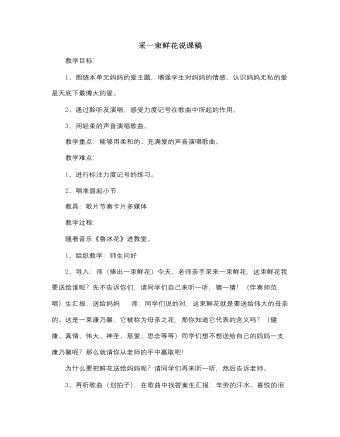
人音版小学音乐四年级上采一束鲜花说课稿
(6)拓展歌曲《妈妈,我不怕黑》五月,是母亲的节日,可是就在2008年5月12日,四川省汶川地区发生了里氏8级大地震,在救援中有这样的一个手机妈妈的故事。救援人员在废墟里发现一位被垮塌下来的房子压死的妇女,她双膝跪着,整个上身向前匍匐着,双手扶着地支撑着身体,身体被压的变形了,在她的身体下面躺着她的孩子,因为母亲身体庇护着,孩子毫发未伤,抱出来的时候,他还安静的睡着,随行的医生准备检查时,发现有一部手机塞在孩子的被子里,屏幕上是一条已经写好的短信亲爱的宝贝,如果你能活着,一定要记住我爱你。5.总结 请同学们把你手中的鲜花献给妈妈,大声的对她说:妈妈,我爱你。告诉妈妈,我们已经长大了,我们懂事了,让我们再一次唱起这首献给妈妈的歌,唱着歌离开教室。
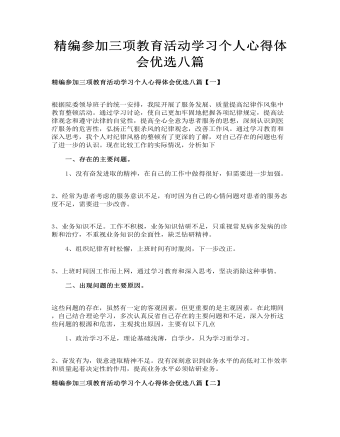
精编参加三项教育活动学习个人心得体会优选八篇
一、存在的主要问题。 1、没有奋发进取的精神,在自己的工作中做得很好,但需要进一步加强。 2、经常为患者考虑的服务意识不足,有时因为自己的心情问题对患者的服务态度不足,需要进一步改善。 3、业务知识不足。工作不积极,业务知识钻研不足,只重视常见病多发病的诊断和治疗,不重视业务知识的全面性,缺乏钻研精神。 4、组织纪律有时松懈,上班时间有时脱岗,下一步改正。 5、上班时间因工作而上网,通过学习教育和深入思考,坚决消除这种事情。

